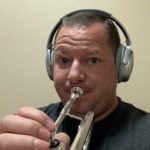WindWorks Trumpet Academy › Forums › WindWorks › Why faster air doesn’t change the pitch – thoughts on Andante Lips and Air Video
- This topic has 3 replies, 3 voices, and was last updated 2 years, 9 months ago by
paulholly.
-
AuthorPosts
-
-
1 September 2021 at 11:49 pm #96764
 Rob ThomsonParticipant
Rob ThomsonParticipantHey Greg,
Your ukulele demonstration made me think of a violin, and I think it may be even more illustrative of the concept. A violinist can move the bow as fast and hard as she wants to, but the pitch won’t change because the thing that determines the pitch is the length of the vibrating medium – in this case, the string. In the case of trumpet playing, the vibrating medium is the lip tissue between the aperture corners. The air is like a violinist’s bow.
I think the misconception stems from an understanding that the medium must vibrate more or less quickly to change pitch, but not understanding the physics of how that does and does not occur, i.e. faster bow/air vs. length of the vibrating medium.
A vibrating medium of a given length will vibrate at the frequency that corresponds to its length, and cannot vibrate at any other frequency. Hitting it harder with faster air results in an increase in the distance of the wave peaks from baseline, but does not shorten the wave (louder, not higher).
Best,
Rob
-
6 September 2021 at 11:07 am #97324
 Greg SpenceKeymaster
Greg SpenceKeymasterHey Rob, thanks for posting this.
Yeah, velocity and frequency are a tricky one to get the head around.
It also stems from the sensation of the body engaging to play higher notes louder, thus the assumption is made that the body is involved for the higher pitches themselves rather than the volume.
The Singing C Series amply demonstrates how this is an error in awareness 🙂
Cheers,
Greg.p.s. your leadpipe is on its way!!!
-
6 September 2021 at 12:06 pm #97329
 Rob ThomsonParticipant
Rob ThomsonParticipantAwesome! I’m learning more every day.
Cheers,
Rob -
30 October 2021 at 5:26 am #106730
paulholly
ParticipantBriliant posts above. A bit off the wall, but there is a general misconception of air and sound. A sound wave travels at the same speed (i.e. the speed of sound) whatever pitch etc. If the air packet (within which the sound is traversing) is moving then the actual sound’s ‘speed’ is in relation to the air. The sound-wave speed and frequency and air speed and pressure are all largely independent characteristics.
The relationship between pressure and air speed is interesting and one that comes up in relation to the tongue position or lung pressure. So raising the tongue or blowing “harder” (sorry Greg) will increase the speed of the air (possibly) simply because a volume of air is being pushed through a smaller hole or being forced at greater pressure.
Not sure where this is going. I’m still unsure by the value of increasing this flow. Other than increasing flow (amount or speed) of the air provides greater energy and thus the wave amplitude is greater (aka louder). I think the relationship between the lip aperture, lip tension and tongue position is still not 100% clear. Though Greg seems to be closest of any. I’m pretty sure that I can change the pitch with a change to any one of those three, but can’t prove this.
There are STILL great trumpet players saying complete nonsense though and surely the air speed and pitch/frequency relationship needs to get sorted. The violin bow model is great.
-
-
AuthorPosts
- You must be logged in to reply to this topic.
Recent topics
-
Question of Curiosity – To Teeth or Not To Teeth
by
clawsonk123
1 month, 3 weeks ago -
1.O / 2.0 routine
by
jice.gif
2 months, 3 weeks ago -
Abdominal surgery and time off the trumpet
by
DQ
9 months, 3 weeks ago -
Allegro or Presto Practice Routine
by
djm297
10 months, 2 weeks ago -
Tongue lock – Throat lock
by
Ivo Carrabs
11 months, 1 week ago
